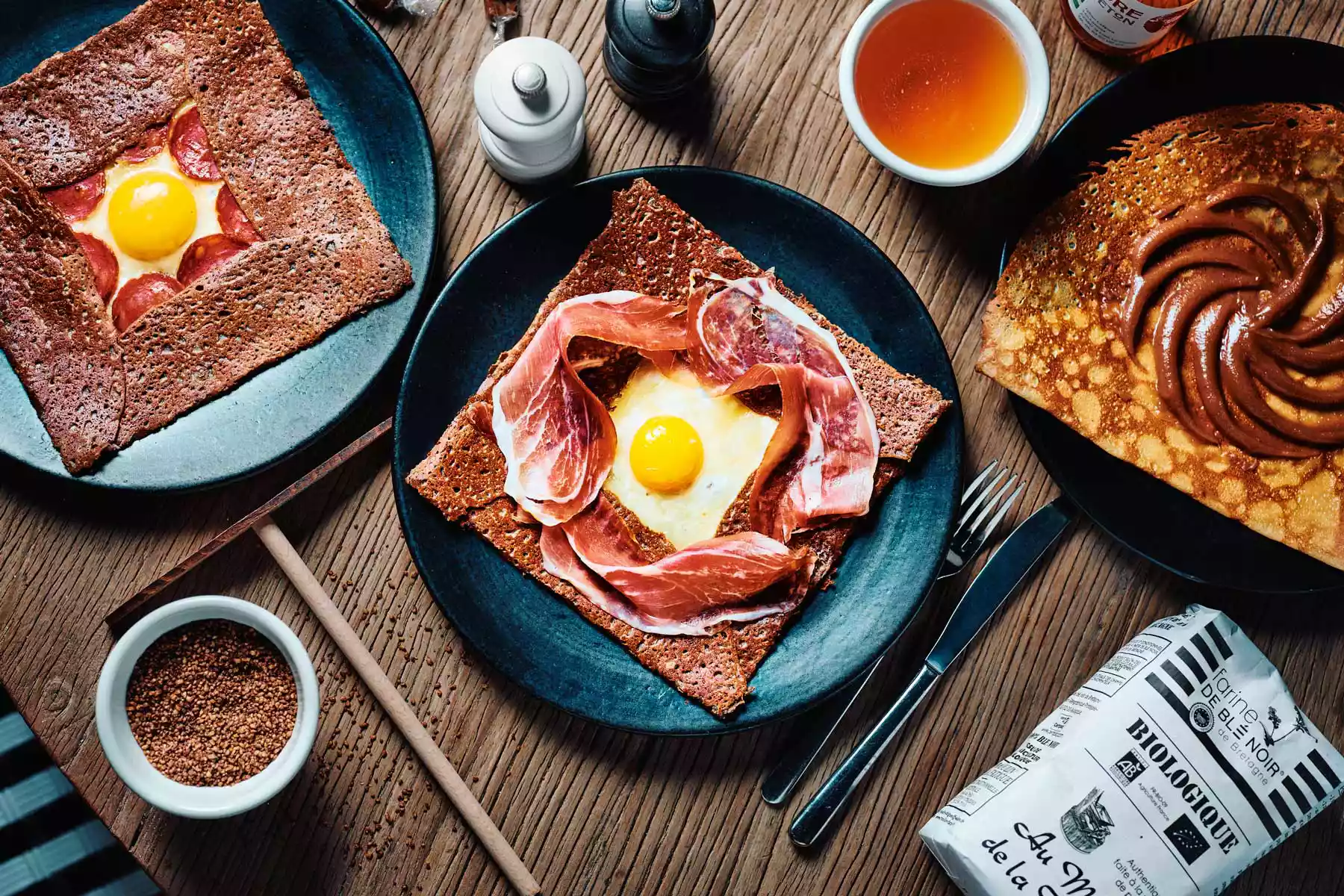1. Introduction
In Brittany, France, crêpes are a treasured local dish—however, making them is no picnic.
2. Crêpe School Experience
Standing in a circle in a converted boatyard facing the port of St.-Malo, in the northwestern French region of Brittany, our small group of strangers introduces ourselves. It’s late February 2020, a few weeks before the COVID-19 pandemic will lock the country down, and months before what would typically be Brittany’s summer tourist season. We are here for crêpe school, and my classmates are all locals—a few retirees, a mother and daughter, one high school senior—most of whom are cashing in gift certificates they’d received at Christmas.
“I’ve lived in St.-Malo for twenty years and I don’t know how to make galettes,” says Béatrice, a pharmacist, using the Breton name for savory crêpes made with buckwheat flour (regular crêpes are made with white flour and are often sweet).
“The last time I made them it was a real catastrophe,” says another classmate, Jacques, a retiree with a walrus mustache. “There was a family petition, and so I’m here,” jokes his friend Jean-François. “I blew the batter, I blew the turning, I blew everything.”
:max_bytes(150000):strip_icc():format(webp)/saint-malo-france-BRITTANYCREPES0921-fc266cb55954498b8731800668587a7e.jpg)
3. Crêpes: A Culinary Staple in Brittany
Galettes and crêpes are to Brittany what pizza is to Naples: a representative staple and an earliest dining-out memory. Here, mom-and-pop crêperies are ubiquitous—there are some 1,800 establishments specializing in this inexpensive dish. In most savory varieties, the crusty edges ooze with melted cheese, while the sweet crêpes are smeared with Nutella, jam, or chestnut cream.
The Atelier de la Crêpe—where I find myself tying on an apron with my new friends in a teaching kitchen early on a Saturday morning—aims to elevate Brittany’s most iconic food. The school has typically offered six-week certificate programs for aspiring professional crêpiers, which include lessons on the history and heritage of buckwheat. It also opens up its battalion of traditional cast-iron Billig griddles to amateurs, who can do four-hour introductory courses like the one I signed up for.
The school is the vision of restaurateur Bertrand Larcher, a local celebrity who launched the state-of-the-art facility in the fall of 2018. Larcher has spent almost 25 years promoting Brittany’s food culture with his empire of Breizh Cafés, which can be found in Tokyo and Paris, as well as in St.-Malo and nearby Cancale. These establishments serve contemporary versions of standard crêpes, made with organic flours and top-of-the-line Bordier butter, and pair them with natural wines or small-batch apple ciders. “To seduce the new generation you have to present things in a new way,” he says.
4. Avant-Garde Culinary Initiatives
Larcher, who grew up on a farm in northeastern Brittany, started his hospitality career in Switzerland. There, he met his Japanese wife, Yuko, a perfumer, and in 1995 they moved to Tokyo, where he opened the city’s first Breton crêperie.
:max_bytes(150000):strip_icc():format(webp)/bertrand-larcher-BRITTANYCREPES0921-28d0e2623fdb40f88d9b35636233d69d.jpg)
When Larcher returned home to Brittany with Yuko and their five kids, they moved to the coast in St.-Malo. He’s been investing in his new hometown ever since, with help from billionaire benefactor and Brittany native François Pinault, the founder of luxury fashion group Kering (which owns brands like Yves Saint Laurent, Alexander McQueen, and Gucci). Pinault is now Larcher’s partner in the expansion of Breizh Cafés.
The flagship, Le Comptoir Breizh Café, is in St.-Malo; it turns out remarkable, delicate crêpes made from superior ingredients, whether a maki-style roll or a classic complète filled with salty ham, runny egg, and nutty Comté. Larcher also operates a Japanese bistro, Otonali, next door to his St.-Malo crêperie, plus a boutique that sells buckwheat pasta and flour, salted caramels, and honey.
5. Future Plans and Sustainability
Larcher also purchased a rambling farm above the sea in St.-Coulomb, just outside St.-Malo, where he is planning an ambitious epicurean retreat, still years from fruition, that will include restaurants, hotel rooms, and a spa, along with acres of farmland to grow food on-site. Larcher has already planted 3,000 apple saplings with the goal of producing cider and 20 acres of buckwheat for milling into flour for—what else?—crêpes.
6. Unique Culinary Offerings in Cognac
“This farm, like everything, will be a bit Japanese, a bit Breton,” he says, tromping through the property’s muddy fields in his wellies. “You’ll be able to eat a galette and drink some sake, with a view of the sea.”
While the farm project percolates, the Atelier de la Crêpe remains Larcher’s proudest achievement. He hopes the school will help him make a case for inscribing Breton crêpes on UNESCO’s Intangible Cultural Heritage list, alongside other culinary treasures like Belgian beer and North African couscous.
:max_bytes(150000):strip_icc():format(webp)/crepe-in-progress-BRITTANYCREPES0921-578206dcde95418e91e11bb8a4fe155b.jpg)
7. Insights from Cooking Class
My own Saturday-morning class at the school turns out to be a surprising challenge. Our chef-instructor, Claude Hirlay, shows a hands-on method for whipping up buckwheat batter, rolling up a sleeve, thrusting a forearm into the bowl, and beating the mixture back and forth—whack! WHACK!—until the batter is thick and airy.
We get our Billigs smoking hot before ladling on batter. Inching the liquid into an even layer with our rozells (wooden batter spreaders) requires speed and dexterity. The finished galettes should be almost thin enough to read a newspaper through but solid enough to support lots of fillings, Hirlay tells us. Mine turned out to be a mangled mess—gloopy, misshapen, and falling apart.
“It takes practice,” he says. “People think this job is easy. Just imagine if you were trying to handle six orders at once.”
8. Conclusion and Recommendations
St.-Malo is three hours from Paris by train. L’Atelier de la Crêpe offers four-hour amateur classes on weekends.
Thirty minutes east of St.-Malo in Cancale, Bertrand Larcher operates a small guesthouse above the town’s outpost of the Breizh Café (a great place to see crêpe masters in action). Most rooms have views of the oyster beds in the Bay of Mont-St.-Michel, just across the street.




